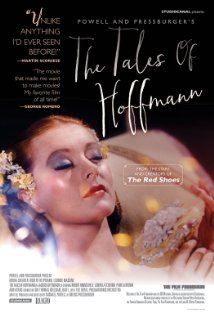
THE TALES OF HOFFMAN
UK, 1951, 128 minutes, Colour.
Robert Rounseville, Moira Shearer, Ludmilla Tcherina, Ann Ayars, Pamela Brown, Leonide Massine, Robert Helpmann, Frederick Ashton, Mogens Wieth.
Directed by Michael Powell, and Emeric Pressburger.
Michael Powell had established himself as a significant British director in the 1930s. In working with Emeric Pressburger, the couple calling themselves The Archers, they produced a body of work during the 1940s which is quite outstanding, war efforts like One of Our Aircraft is Missing, the satiric The Life and Death of the Colonel Blimp, local dramas like The Canterbury Tales and I Know Where I am Going. In 1947, they made the striking drama of Anglican nuns in India (all filmed in British studios), Black Narcissus. They followed with the classic ballet film, The Red Shoes, with Moira Shearer and Robert Helpmann.
After some dramas and melodramas, they attempted the very ambitious The Tales of Hoffman, based on Offenbach’s music, in 1951. They brought their visual talent to bear with the staging of the ballet and opera sequences, the costumes and decor, on-screen in vivid colour. The film is quite stagebound, opening in an inn in Nuremburg with Hoffman beginning his tales, sung and danced by American Robert Rounseville. Robert Helpmann has four different roles, some sinister, some dramatic, a tour de force from the Australian actor, choreographer and ballet dancer. Ballerinas like Moira Shearer and Ludmilla Tcherina play different roles offering a variety of dancing styles. On the male side, Leonid Massine also has a number of roles in quite different dancing styles. Frederick Ashton, who choreographed the film, also appears in several dancing roles. Opera singer, Ann Ayars has an operatic tale of her own.
The film was severely cut for release and it is only in the 21st century that the full film has been painstakingly restored, urged on by Martin Scorsese who, in an interview, explains it was one of the films that had a great influence on him when he was young.
Audiences who do not respond immediately to opera and ballet might find the experience somewhat trying – but will be in admiration of the cinematic, musical and dancing skills that have been brought to this film, remembering also that it was made in the early 1950s.
1. The work of the Archers, during the 1940s, into the 1950s? The lavish style, melodrama, use of colour, music? Delight in music and ballet?
2. 1951, the work of Offenbach, the cast, singing and dancing, professionals, the use of actors? The screenplay, the translation?
3. The credits, the explanation? The ending?
4. The staging, the photography, the musical score? Sets and costumes? The touch of the exotic?
5. Special effects, the transitions between scenes, the performers and the taking different roles in different stories? Pamela Brown as Niklaus?
6. The introduction, Hoffman, Nuremberg, the Tavern, his stories? The hero, his tales, loves, sadness, women, the roles of Robert Helpmann as an antagonist?
7. Robert Helpman, sinister influences, relationships, jealousy, the note, the glasses? As Lindorf, Coppelius, Dapertutto, Dr Miracle?
8. The dancing of Leonide Massine, the different characters, his range of dance?
9. The ballerinas, Moira Shearer, Ludmilla Tcherina? The characters, the range?
10. Robert Rounseville and his singing, performance?
11. Frederick Ashton, his choreography, his characters?
12. Ballet, choreography, staging? Opera and voices? Songs and emotions?
13. The popularity of Offenbach’s Bacarolle, the exotic settings?
14. The style of dancing, classic, of its period, later?
15. The ending and the presentation of performers and characters?
16. An exotic musical, ballet and opera experience?